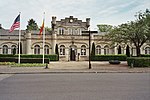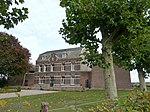De Valkenier

De Valkenier (English: The falconer) was an amusement park in Valkenburg aan de Geul, Netherlands. The attractions focused mostly on families with children below the age of twelve. Founded by Jan Albert Otermans in 1934 under the name Ontspanningsoord Natuurbad Valkenburg (English: Recreational natural pool Valkenburg) it was the oldest amusement park in the Benelux countries. Starting with a rowing pond with a playground and pool, the park added attractions over the years and slowly grew into a modern amusement park. A rollercoaster and other mechanised entertainment was introduced in the 1970s and 1980s and the name of the park was changed to De Valkenier.
Excerpt from the Wikipedia article De Valkenier (License: CC BY-SA 3.0, Authors, Images).De Valkenier
Koningswinkelstraat, Valkenburg aan de Geul
Geographical coordinates (GPS) Address Nearby Places Show on map
Geographical coordinates (GPS)
| Latitude | Longitude |
|---|---|
| N 50.868 ° | E 5.824 ° |
Address
Koningswinkelstraat 49
6301 WH Valkenburg aan de Geul
Limburg, Netherlands
Open on Google Maps








